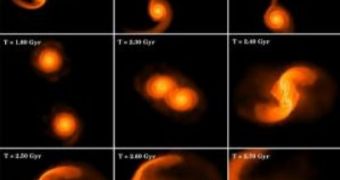Most astrophysicists believe that galactic merges are the most important processes that create new galaxies. Two galaxies speeding towards each other eventually collide, giving birth to a supergalaxy, and cosmologists think that's how most galaxies grow, through a complex process of continuous mergers.
The Milky Way is a giant disk of stars, gas, a giant spheroid and a huge halo of dark matter that spirals around a supermassive black hole, at the center of the galaxy. Two galaxies, each having around 100 billion solar masses, like our galaxy, an average one, in fact, merge to create a giant mass of matter, up to a few hundred million to a billion solar masses.
Most astronomers believe that sometime in the distant future, our galaxy, the Milky Way, and Andromeda, the closest galaxy, will collide in a massive cosmic clash. However, they can't still accurately predict whether this will occur in 2, 5 or 10 billion years.
A group of scientists reported the first simulation of a supermassive black hole (SMBH) that forms in the center of the merged galaxies, up to a few thousand light years wide.
"The theory of General Relativity that Einstein developed about 90 years ago which describes the behavior of gravity has been verified in many of its predictions," says Stanford co-author Stelios Kazantzidis of the Kavli Institute for Particle Astrophysics and Cosmology.
"However, there is one major consequence of this theory that has yet escaped verification, and this is the existence of gravitational waves. Due to the fact that coalescing SMBH binaries constitute the most powerful sources of gravitational-wave emission in the universe, it is of primary importance to establish the necessary conditions leading to the merger of two SMBHs."
The simulations produced impressive results, showing that a pair of SMBHs form a binary system that reduces the space between the two black holes until they finally merge, producing strong gravitational waves.
This is the first time that a galactic merger is followed through the formation of a gravitationally bound SMBH binary and down to scales of only a few light years.

 14 DAY TRIAL //
14 DAY TRIAL //